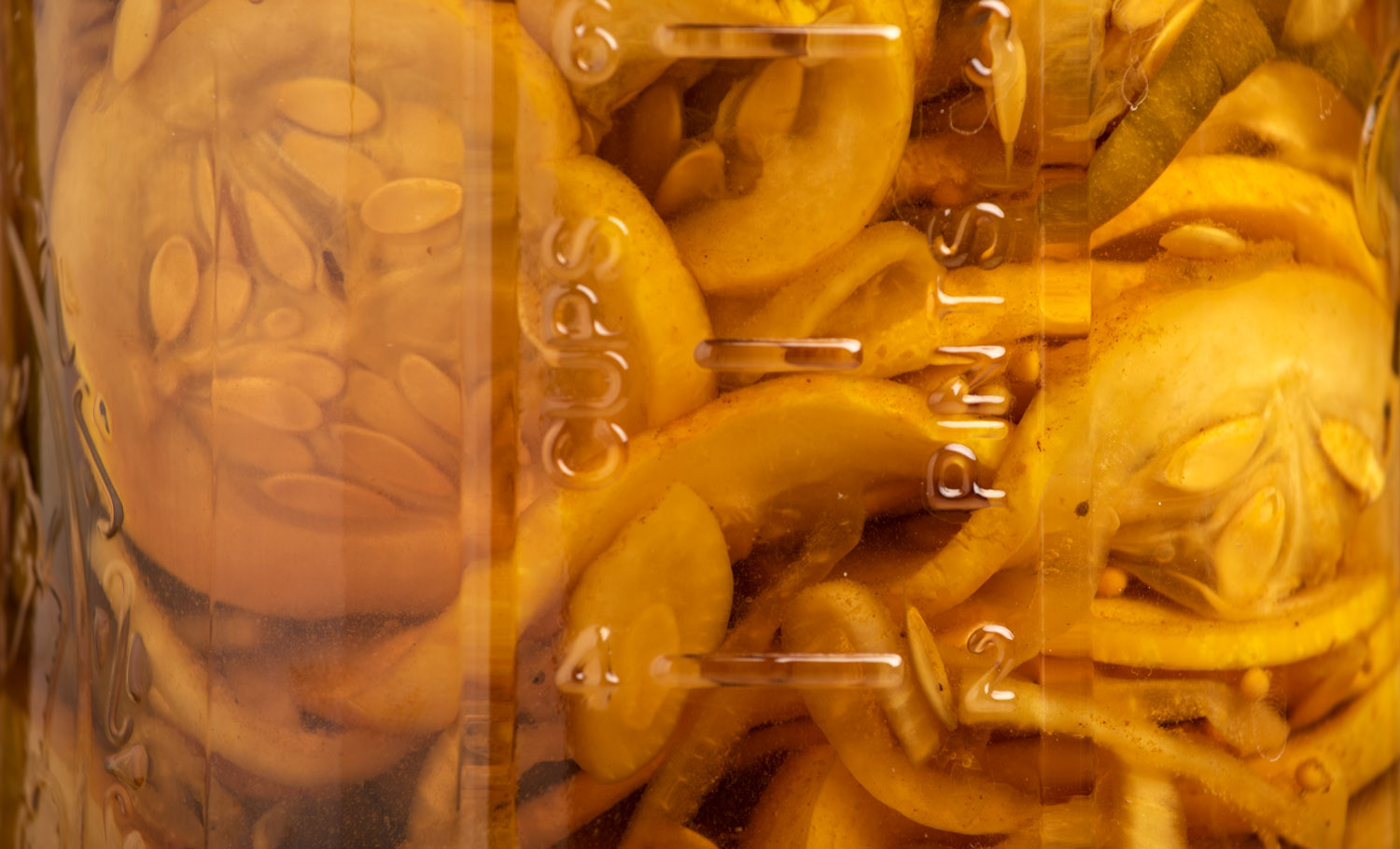A World of Pickles
Photos by Forrest Anderson
One of the great pleasures of international travel is exploring the variety of ways in which people in different cultures solve the same problem. Among the most interesting is how people preserve food. Throughout most of the world, the growing season is limited to a few months, and people have had to figure out ways to preserve and store food to stave off famine for the rest of the year.
Among the most common and versatile preservation methods is pickling. Almost any vegetable and many other foods are pickled somewhere in the world, and some cultures have a wide variety of pickled vegetables.

For millennia, people have faced the problem of how to preserve surplus fresh produce at harvest time. Pickling is one of the most common solutions.
Europe
In Italy, a versatile mix of vegetables called giardiniera is pickled in spices, using whatever is available in the garden. Beets, lemons and olives are pickled in salt, vinegar and herbs in the Middle East and Eastern Europe. Tiny cucumbers called cornichons are preserved in vinegar with tarragon, onion, garlic, dill and cloves in France. Gherkins made from small gherkin cucumbers are popular in Britain and other parts of Europe. They are flavored with dill, garlic and sometimes sugar.
Cucumbers are pickled across northern Europe. German sauerkraut is pickled cabbage and food historians believe it originated in China. Sauerkraut is used in soups, salads and sandwiches as well as other meals in Europe. It has many regional varieties that include other vegetables and spices, with one of the most popular in the United States being pineapple sauerkraut that is used on pineapple pizza.
Pickles aren’t limited to vegetables in Europe – herring is pickled in Scandinavia and eggs in Britain. Both pickled onions and pickled eggs are often sold in pubs and fish and chip shops. Piccalilli, a pickled mixture, is typically eaten with pork pies, cold meats and sandwiches.
Giardiniera
Giardiniera is delicious alone or in pasta salads and as a garnish on pizza.

INGREDIENTS
These are suggested vegetables, but I just use what I have on hand, making sure that the total amount is the same as the recipe.
3 cups cauliflower florets or zucchini slices
1½ cups grated or sliced carrots
1½ cups sliced celery
1½ cups sliced red bell pepper
1 cup pitted green olives
4 tbsp. olive oil
4 cloves garlic, smashed
4 bay leaves
2-4 small dried chilies
1 tsp. celery seeds
1 tsp. fennel seeds
1 tsp. yellow mustard seeds
For brine:
3 cups water
3 cups white vinegar
2 tbsp. salt
2 tbsp. sugar
DIRECTIONS
Chop all of the fresh produce into bite-sized pieces. Drain the olives. Set out 4 clean pint jars.
Add to each jar 1 tbsp. olive oil, 1 mashed garlic clove, 1 bay leaf, ½ chili, ½ tsp. oregano, ¼ tsp. celery seeds, ¼ tsp fennel seeds, 1/4 tsp mustard seeds.
Divide the vegetables and olives into fourths and put ¼ in each jar so they are filled to the top.
In a saucepan over high heat, add the water, vinegar, salt and sugar and bring to a boil. Stir, then pour brine into each jar.
Allow the jars to cool at room temperature, cover them with lids, shake them and refrigerate them for 36-48 hours before eating.
Asia
The variety of pickles in Asia is mind boggling. It is a rare meal in many Asian countries that doesn’t include something pickled.
Ginger is pickled in Japan and one of the most common Japanese dishes is tsukemono, or mixed pickled vegetables. No one pickles cabbage like the Koreans, who serve it and other pickled vegetables in spicey mixes called kimchi. Kimchi is Korea’s national dish and many families carefully guard and pass down to younger generations their special kimchi recipes.
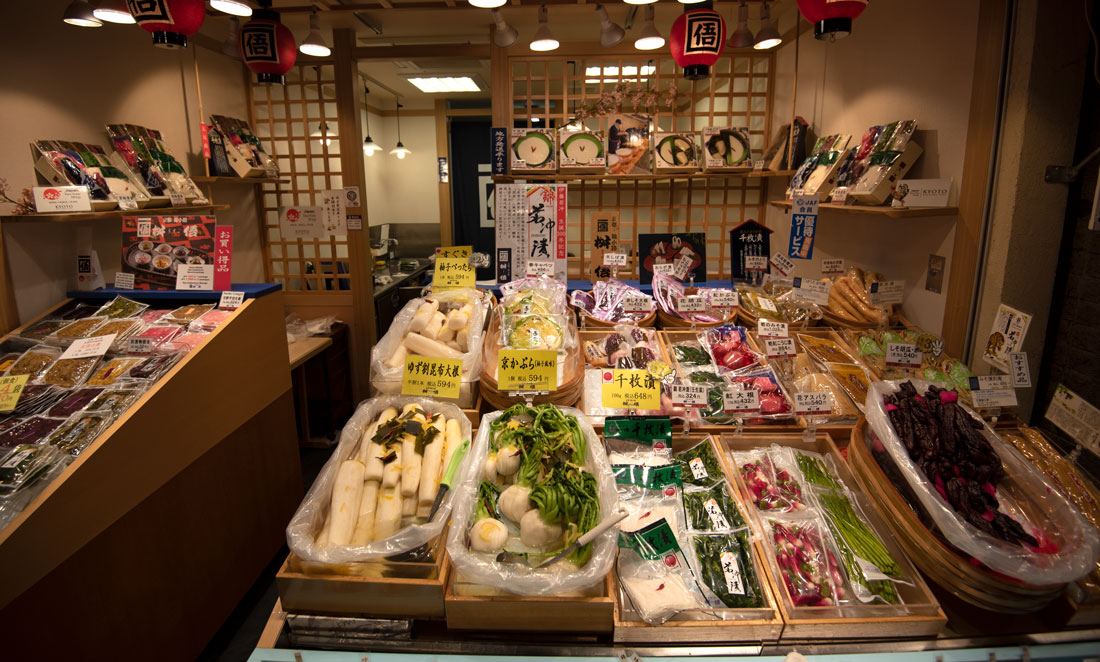
A store that sells a variety of pickled vegetables in a market in Kyoto, Japan.
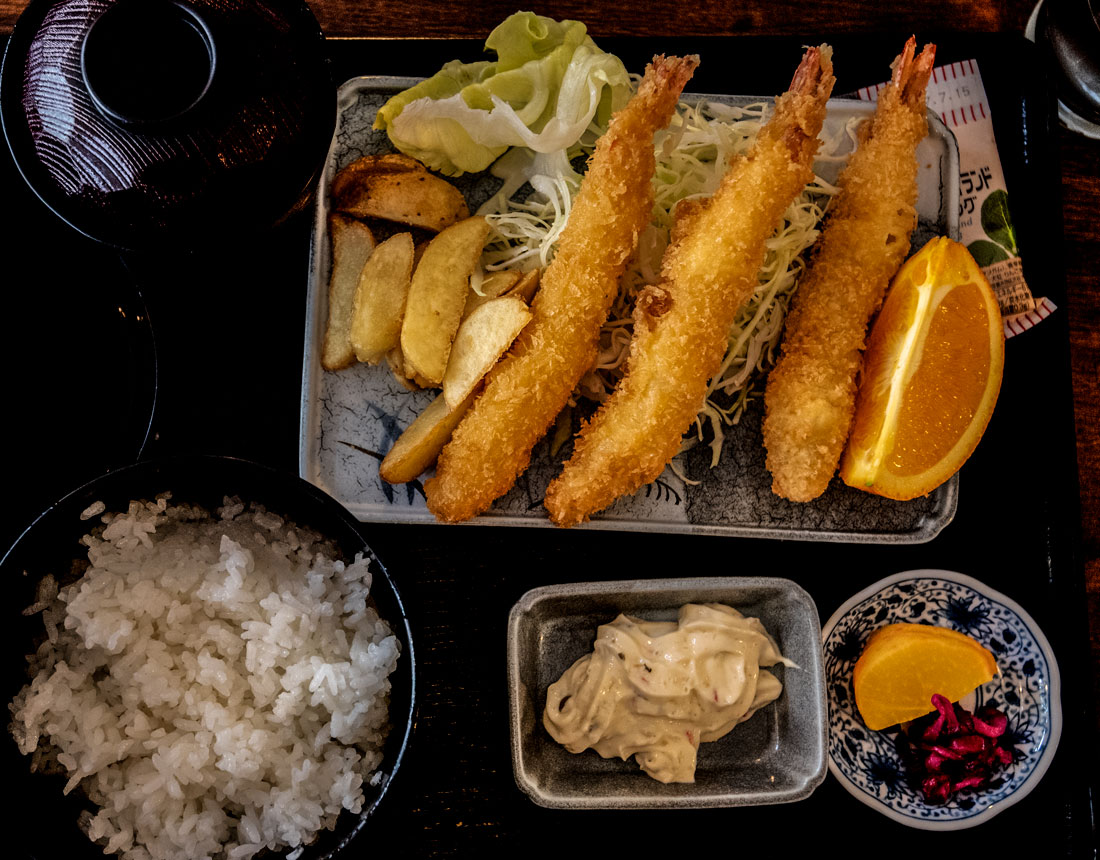
This Japanese meal includes a small dish of pickles in the lower right corner. Pickles are an everyday dish in many Asian countries.
Mangos are commonly pickled in Southeast Asia and Africa. Pickles are central to Indian cooking, with those made of mango and lime the best known. They often are richly flavored with a variety of spices and come in many forms, with regional variations.
Pickles are one of the most common foods in China, and there are well over a hundred kinds of Chinese pickles. Pickled cabbage, eggs, lettuce, cucumbers, mustard, radishes and bamboos shoots are the most common. In Sichuan, spicy pickles are a standard dish at the table. They are served with noodles, Chinese dumplings, and savory rice porridge which is a common breakfast food.
Green papaya is pickled in the Philippines, sometimes along with carrots, onions, daikon radish, bell or chili peppers, pineapple chunks or raisins.
Refrigerator Sweet Soy-Pickled Cucumbers
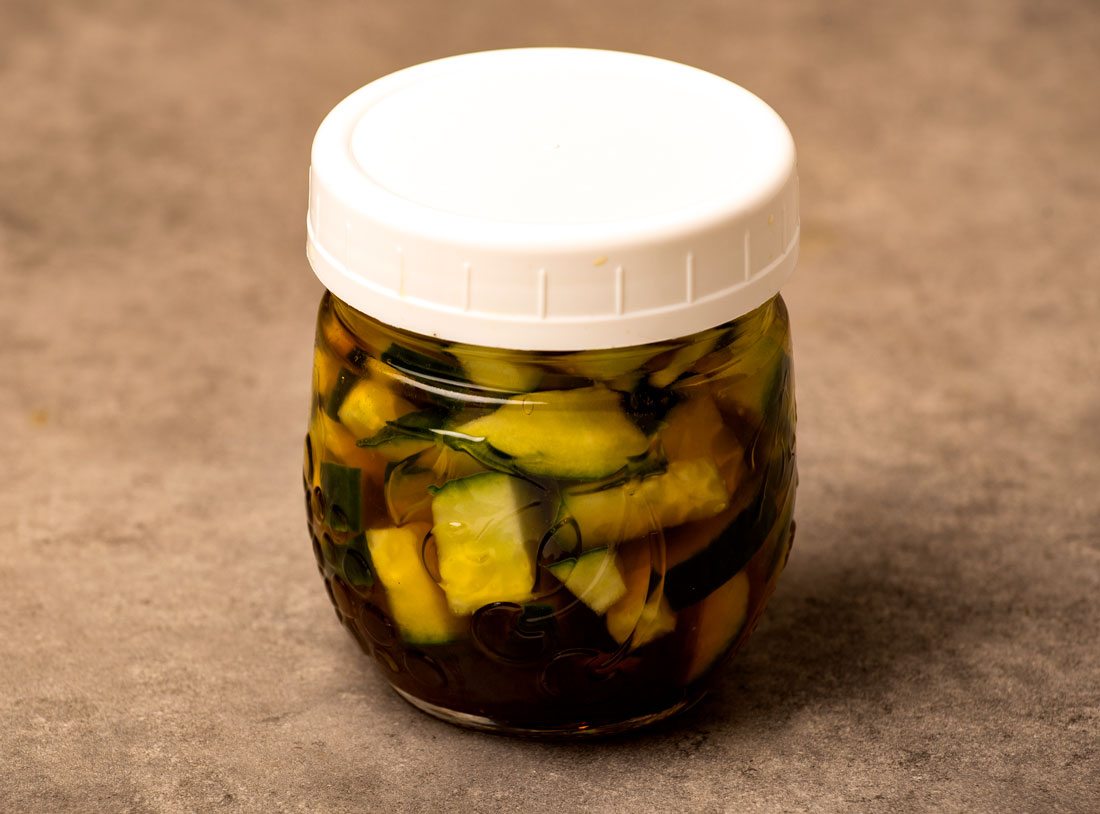
INGREDIENTS
1 lb. cucumbers, preferably small pickling ones but I use others all of the time for this recipe
2 tsp. salt
½ cup rice vinegar
¼ cup soy sauce
¼ cup water
¼ cup sugar
1 star anise
DIRECTIONS
Chop cucumbers into 1/2-inch pieces. In a bowl, toss with the salt and let sit for 30 minutes. Rinse under cold water. Drain and squeeze gently to remove excess liquid.
Combine the vinegar, soy sauce, water, sugar and star anise in a saucepan over medium-high heat and bring to a boil, stirring to dissolve the sugar. Let cool to room temperature and discard the star anise. Place the cucumbers in an air-tight jar and pour the vinegar mixture over them. Cover and refrigerate for 24 hours before serving. Stores in the refrigerator for up to 1 week.
Refrigerator Fennel Pickled Cucumbers
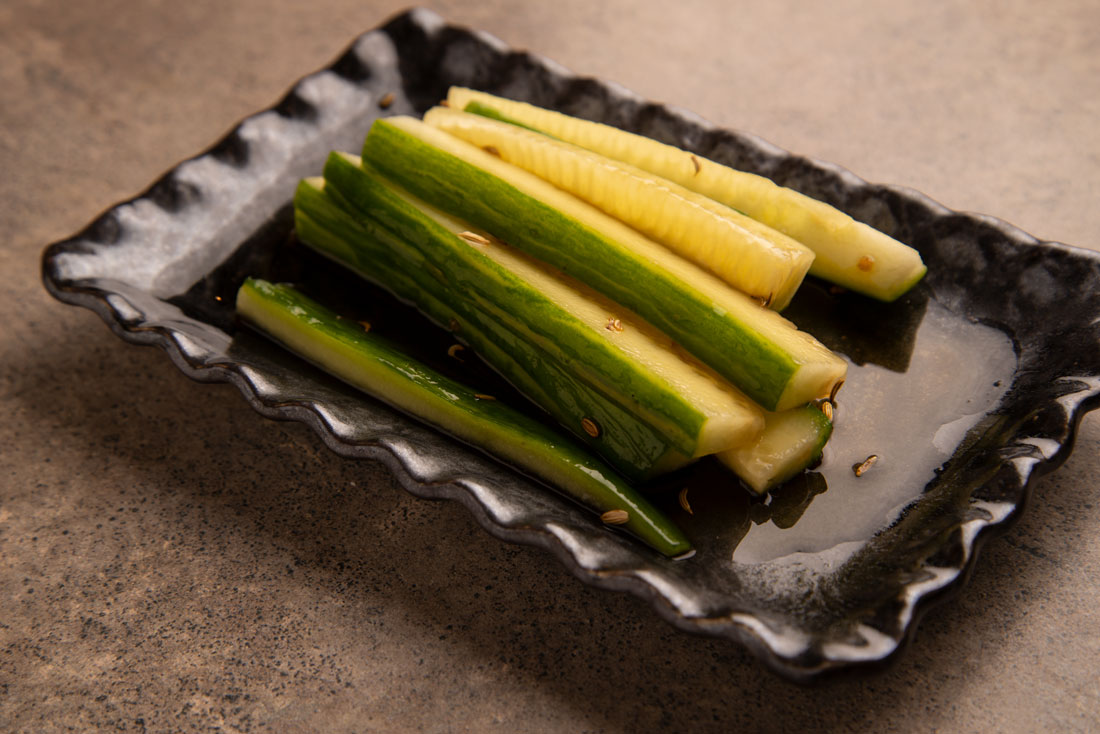
INGREDIENTS
12 oz. Persian cucumbers, cut in strips
½ cup soy sauce
3 tbsp. brown sugar
3 tbsp. rice vinegar
¼ tsp. fennel seeds
DIRECTIONS
Combine the ingredients in a small saucepan. Bring to a boil over medium-high heat and cook for 1 minute, stirring twice to make sure the cucumbers are coated. Transfer the cucumbers and liquid to a pint jar. The cucumbers should be completely submerged. Cover and chill for at least 12 hours. They will keep refrigerated for 2 weeks.
Refrigerator Chinese Mixed Pickles
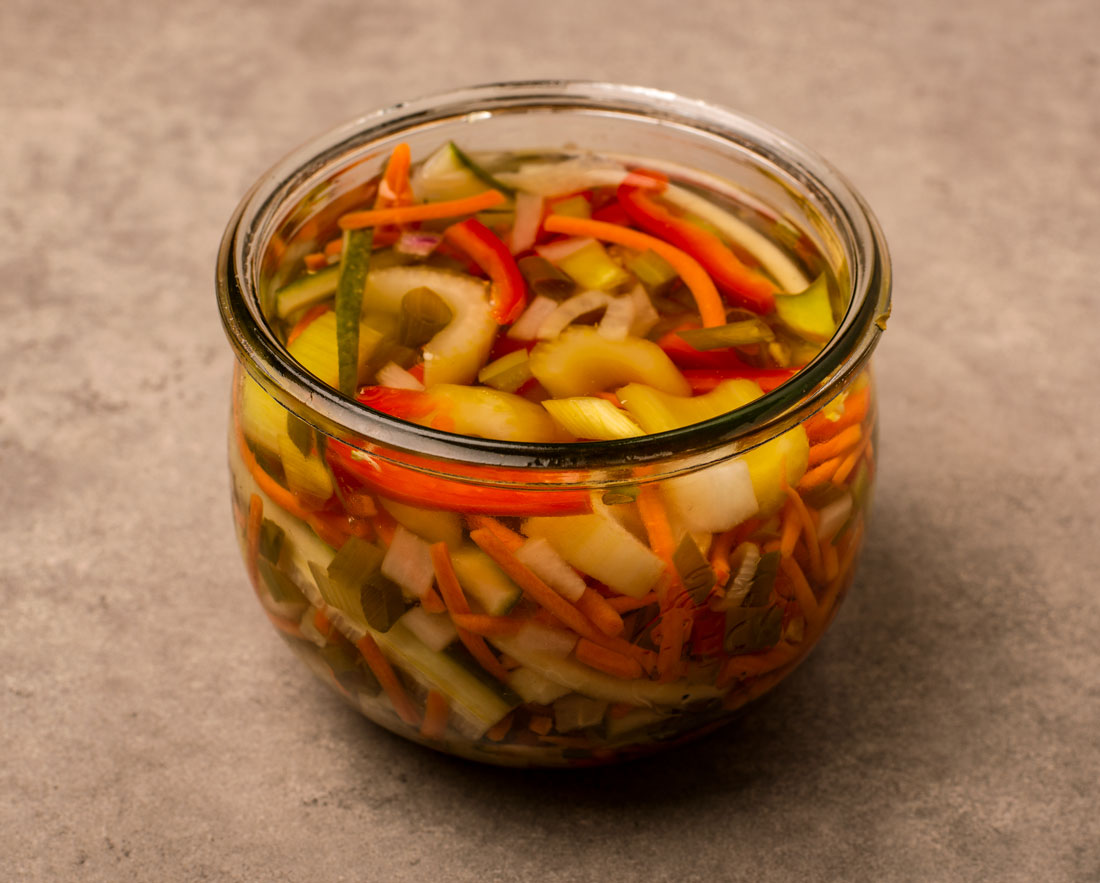
INGREDIENTS
3 cups sugar
3 cups white vinegar
1 ½ cups water
1 ½ tsp. salt
3 shredded carrots
1 large Chinese white radish, peeled and cut into thin sticks
1 cucumber, cut in quarters
4 stalks celery, cut into 1/2-inch diagonal slices
8 scallions, cut into ¼-inch diagonal slices
½ tsp. ginger powder
1 red pepper, sliced
1 green pepper, sliced
DIRECTIONS
Combine the first four ingredients in a saucepan and cook until boiling. Remove from heat.
Fill a Dutch oven half full of water, cover and cook over high heat until boiling. Add all vegetables and remove the pan from the heat immediately. Let the vegetables stand overcovered for 2 minutes. Then drain them in a colander. Spread them out a towel and pat them dry.
Pack the vegetables firmly into clean jars with lids. Pour the pickling liquid into the jars until the vegetables are completely covered. Place lids tightly on the jars and store in the refrigerator until you want to use them. Stores refrigerated for 2-3 weeks.
North America
The United States and Canada have a rich pickling tradition because of the many immigrants from different countries who brought their pickle recipes with them. The United States even has a National Pickle Day in November. Americans pickle cucumbers and relishes using a variety of vegetables. The Pennsylvania Dutch pickle eggs with beets.
Dill pickles and kosher dill pickles are especially popular in the United States. The word kosher refers to the Jewish picklers who flavored dill pickles with garlic in New York City. Pickled vegetables were a staple in the diets of Jews in the Ukraine, Poland, Lithuania and Russia. Barrels were filled with cucumbers, beets and shredded cabbage and stored in cold dark cellars for winter. When eastern European Jews emigrated to New York City in the late 1800s and early 1900s, they introduced kosher dill pickles to America. They piled washed cucumbers in large wooden barrels with dill, garlic, spices, kosher salt and clean water and let them ferment for a few weeks to several months before selling them from carts on the streets. Jewish-owned shops selling pickles out of barrels also appeared. Today, a plate of pickles is often served as a complimentary dish at Jewish delis in the United States.
Kosher Dill Pickles
A wide variety of dill pickles are made, ranging from mild to strong and spicey.

INGREDIENTS
2 ½ lbs. cucumbers (pickling ones are better, but I use others as well)
2 ½ cups water
2 cups white vinegar
¼ cup sugar
¼ cup pickling salt
4 cloves garlic
4 bay leaves
12 dill sprigs
2 tsp. mustard seeds
4 small chiles (these are optional to use if you like spicey pickles)
1 tsp. Ball Pickle Crisp (this is optional, but helps make the pickles crisp)
DIRECTIONS
Prepare boiling water canner and heat 4 pint jars in simmering but not boiling water until you are ready to use them. Wash lids and bands in warm soapy water and set them aside.
Wash the cucumbers well and trim the ends off so they are about three inches long. Cut them lengthwise into quarters or slice them.
Combine the water, vinegar, sugar and salt in a small saucepan. Bring to a boil over medium heat, then lower the heat to simmer.
Use a jar lifter to take a jar out of the canner, place it on a towel and place a garlic clove, 3 dill sprigs, ½ tsp. mustard seed, bay leaf, chili (if using), and ¼ tsp. Bell Pickle Crisp (if desired) into the hot jar.
Pack cucumber slices tightly into the jar, leaving ½ inch headspace. Trim cucumbers that are too long.
Fill all of the jars. Ladle the hot liquid into each jar, leaving ½ inch headspace. Remove any air bubbles, and wipe the jar rim. Center the lid on the jar and apply a band, screwing it on to fingertip tight. Place the jars in the boiling water canner.
Bring the water in the canner to a boil and process it for 15 minutes. Turn off the heat, remove the lid, and let the jars stand in the water for 5 minutes. Remove the jars and let them cool for 12-24 hours. Check the lids to make sure they are sealed (they shouldn’t flex when you press your finger on the center). Store until you are ready to open and use the pickles. Once a jar is open, it must be refrigerated.
Canadian pickling is similar to that of Britain. In the Southern United States, pickled okra and watermelon rind are popular, as are deep-fried pickles and pickled pig's feet, pickled eggs, quail eggs, and other pickled foods.
Here are some popular American pickle recipes that I like:
Sugar-free Bread and Butter Pickles
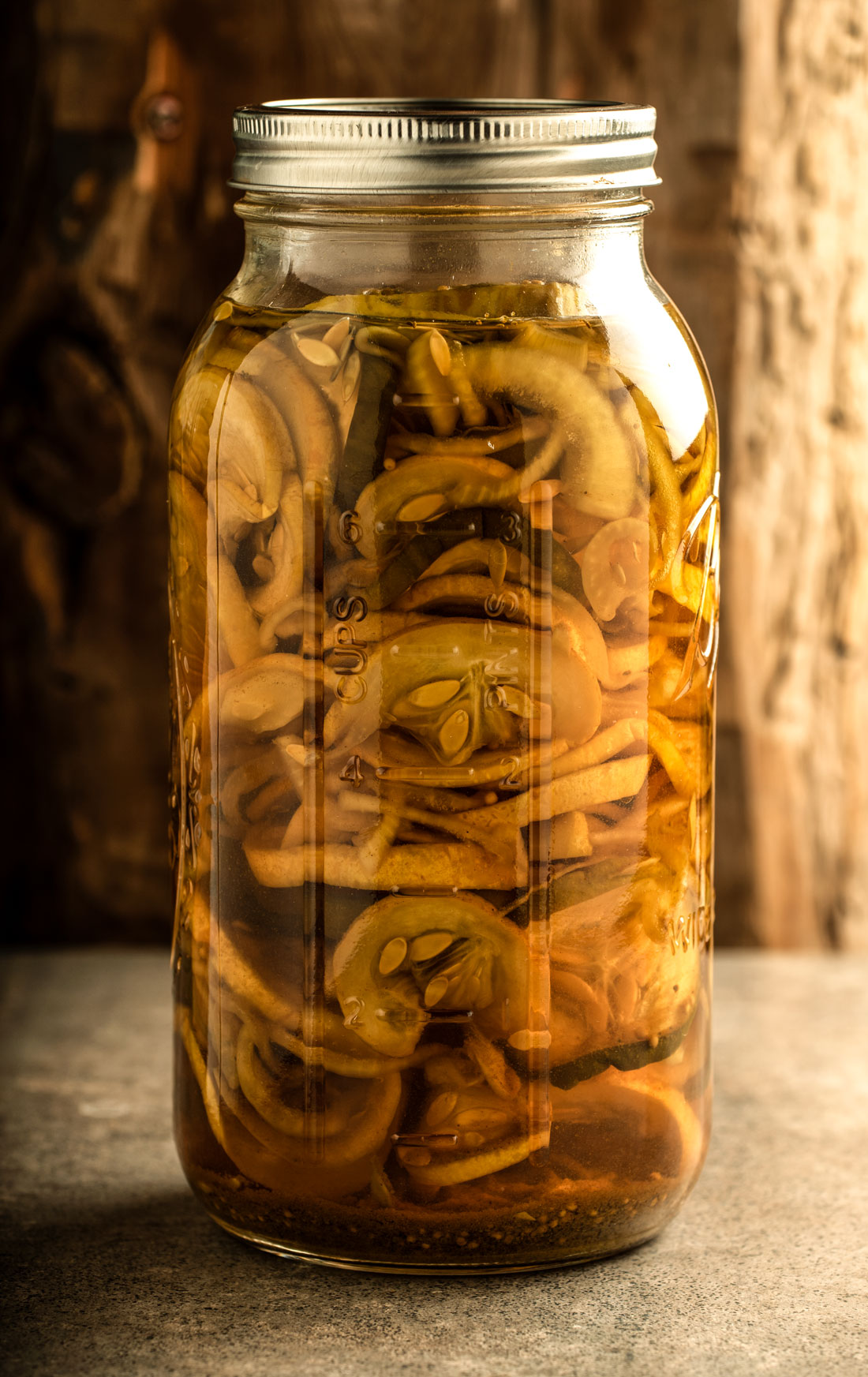
INGREDIENTS
2 lbs. cucumbers cut into ¼-inch slices
1 onion, thinly sliced
3 tbsp. kosher or pickling salt
2 ½ cups white vinegar
1 ¼ cups Splenda Granulated Sweetener
1 tbsp. mustard seeds
1 tsp. celery seeds
1 tsp. turmeric
½ tsp. whole cloves
DIRECTIONS
Wash the cucumbers and onions in a glass bowl. Sprinkle them with the salt and toss them to coat them with the salt. Let them stand at room temperature for two hours.
After the first hour, wash 3 pint jars and lids in hot soapy water and rinse with warm water. Fill a canning pot half full of water and add the jars and enough water to cover them. Bring the water to a boil, then reduce the heat and simmer. Place lids in water to cover in a saucepan, bring water to a simmer and simmer until you are ready to use the jars.
When the vegetables have been in the salt for 2 hours, wash the salt off, rinse them, and drain again. Blot dry using paper towels.
In a large heavy pot, combine vinegar, Splenda, mustard seeds, celery seeds, turmeric and cloves. Boil over medium-high heat. Add the cucumbers and onions and return to a boil.
Pack the hot vegetables into prepared jars using a slotted spoon. Leave ½ inch of headspace at the top of the jars. Ladle the pickling liquid into the jars so that the vegetables are covered at the top, but there still is about ½ inch of headspace at the top.
Wipe the jar rims and thread and cover them with 2-piece lids.
Place the jars in a rack in a canning pot so that water covers the jars by at least 1 inch. Add boiling water if necessary. Cover and bring the water to a gentle boil.
Continue to allow the water to boil for 15 minutes. Remove the jars and place them on a towel to cool completely. After they cool, check the seals by pressing the center of the lid with your finger. If the lid springs back, the lid is not sealed. You can refrigerate these unsealed jars of pickles and use them in 2-3 weeks, but you can’t leave them on a shelf outside of the refrigerator.
Store the sealed jars in a cool dark place. Once you open a jar, store it in the refrigerator and use it within 2 weeks.
Refrigerator Ranch Dressing Pickles
These are good on sandwiches, in potato salads and pasta salads and alone.
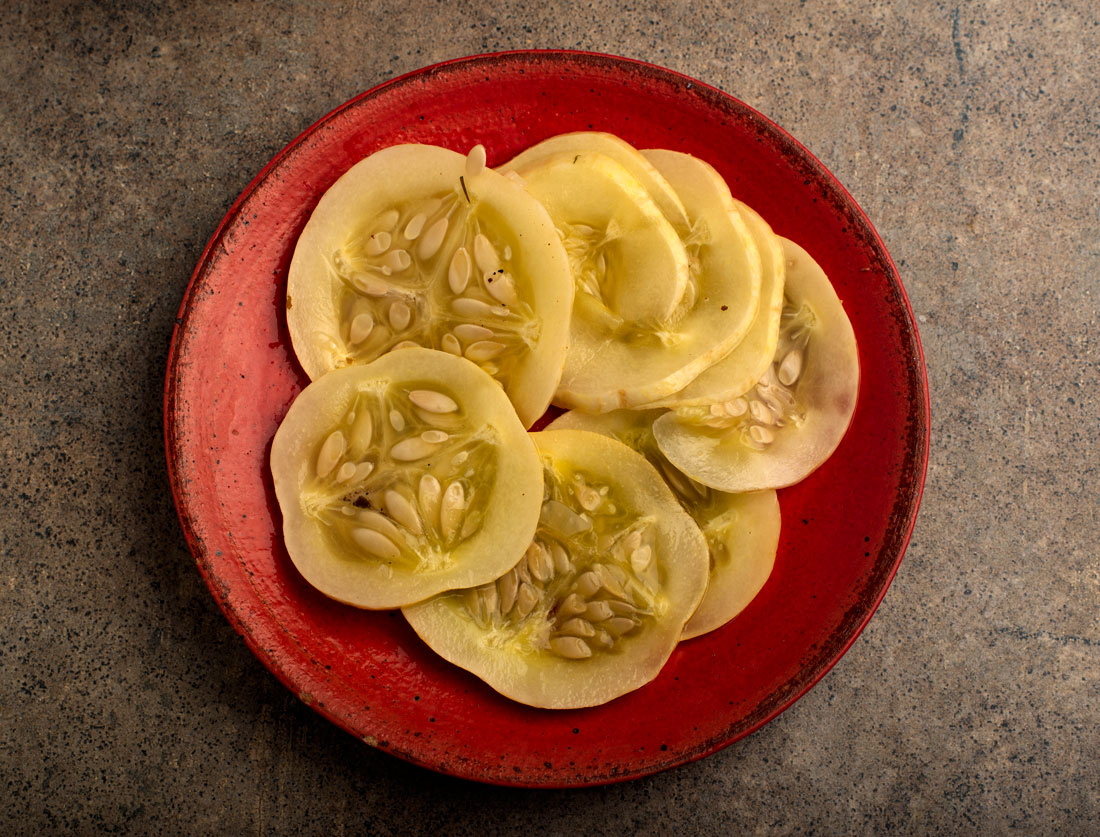
INGREDIENTS
1 cup fresh dill sprigs
¼ cup onion, chopped
2 garlic cloves, chopped
3 cups cucumbers, thinly sliced
1 ½ cups water
¾ cup white vinegar
1 tbsp. granulated sugar
1 1 oz. package of ranch seasoning
¼ tsp. kosher salt
1/8 tsp. black pepper
DIRECTIONS
Place the dill, onion and garlic in a large quart mason jar. Fill the jar to the top with cucumber slices.
Place the water, vinegar, sugar, ranch seasoning, salt and pepper in a saucepan over high heat. Whisk until it boils. Pour the hot mixture over the cucumbers. Cool slightly, place a lid on the jar and refrigerate it overnight.
Latin America
Latin American varieties of pickles include Latin-style spices and vegetables that make them delicious condiments on tacos, salads and enchiladas. Many salsas are basically pickled vegetables with spices.
Mexican pickles usually contain chili peppers, onions and Mexican-style spices and herbs.
In Central American countries, pickles are made with cabbage, onions, carrots, lemon, vinegar, oregano, and salt.
Refrigerator Mexican Pickled Vegetables
This recipe works as a garnish on Mexican soups, salads, taco salads, tacos and fajitas, and enchiladas. It takes on the role of a salsa in adding flavor.
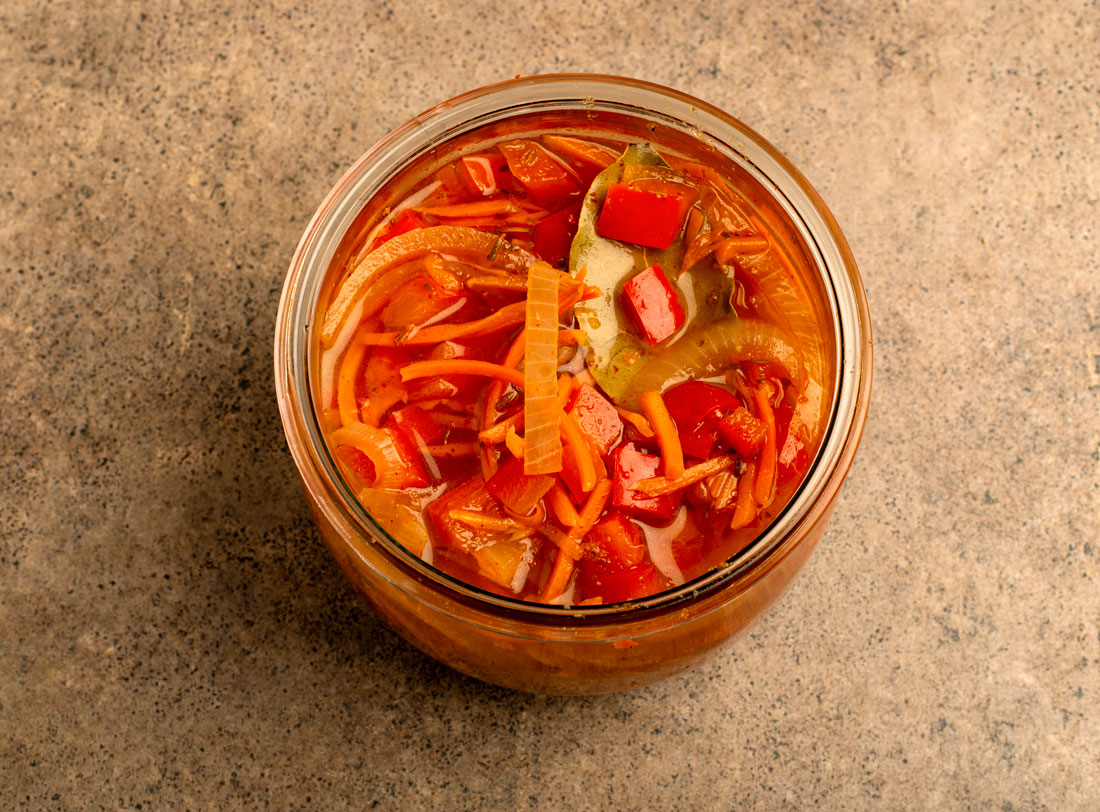
INGREDIENTS
1 ¼ tsp. minced dried garlic
2 carrots, cut into slices or coarsely grated
2 bell peppers, sliced
1 tbsp. chili powder
1 onion, thinly sliced
½ cup cider vinegar
2 bay leaves
½ tsp. dried oregano
½ tsp. dried thyme
Black pepper to taste
DIRECTIONS
Combine the garlic, carrots, bell peppers, chili powder, onion, and 2 tbsp. water in a skillet. Cook, stirring often, until the onion is soft, about 5 minutes.
Add ½ cup water, vinegar, bay leaves, oregano, thyme and pepper. Bring to a boil, then reduce heat, cover and simmer until carrots and peppers are just tender, about 7 minutes.
Transfer vegetables and cooking liquid to a nonmetal bowl and let cool. Cover and refrigerate until the next day.
Pickling is ancient. Kimchi was first mentioned in written documents 2,000 years ago and the Chinese laborers who built the Great Wall ate a form of sauerkraut, according to ancient records. Cleopatra considered pickles a beauty treatment and Aristotle thought they had healing properties. Julius Caesar, Elizabeth I of England, George Washington, Thomas Jefferson and Napoleon Bonaparte all liked pickles. Pickles were once so common that people had special pickle dishes and pickle forks. Pickles were a staple of sailors and travelers aboard ships. The word pickle was derived from the Dutch pekel or northern German pókel, meaning “salt” or “brine.”

An antique pickle dish and fork.
When refrigerators and fresh produce became available year round, pickles’ importance declined somewhat but there has been a resurgence in interest in pickles in recent years because they add a burst of flavor to meat, soups, salads, rice dishes, pizzas and other food. In some cultures such as Iran, Korea and Sichuan, China, pickles are deliberately made spicey to add a kick to food. Generally, pickles are used as an accent to other milder foods. Pickles’ added flavor appeals to chefs, who have revived the use of gourmet pickles at high end restaurants, on food trucks and in other settings.
The three great preservatives are vinegar, salt and sugar, and all are used in the process of pickling, with vinegar and salt taking center stage. Vegetables, fruit and other ingredients ferment in vinegar and a salt brine, to which sugar is sometimes added, to make pickles.
A pickle is basically a food that has been fermented in a brine or vinegar for a period of time. Cucumbers and some other vegetables are excellent for fermentation because they have benign lactobacillus bacteria that occurs naturally in their skin. When they are pickled, this type of bacteria grows and suppresses the development of other bacteria that cause spoiling and disease. The benign bacteria metabolizes the sugar in the vegetable, so that harmful bacteria can’t grow on it, and produces lactic acid and other antibacterial substances such as carbon dioxide and bacteria. The lactic acid preserves the vegetables and gives the pickles tartness while preserving fiber and vitamin C. The beneficial bacteria also increases the amount of B vitamins.
The process starts when the vegetables are pickled in a salt brine that can include flavorings such as spices, herbs, garlic and chiles. The brine should cover the vegetables to limit their exposure to oxygen which can cause the growth of fungus and mold. The vegetables are packed tightly into jars so they can’t float to the surface.
The salinity of the brine depends on what you are pickling. After a day or two of making pickles, bubbles of carbon dioxide gas surround the vegetables, indicating that the lactobacillus is thriving and the brine is acidifying.
To avoid problems with cloudy brine, use pickling or kosher salt rather than table salt which has anti-caking ingredients. Pickling in hard water also can cause cloudiness.
Pickles are crisper if you start with very fresh vegetables. Adding grape leaves can help keep the vegetables crisp.
The most common types of vinegar used in pickling are white vinegar and white wine vinegar because they don’t affect the color of most vegetables. Another common option is cider vinegar, which has a milder flavor but causes vegetables to darken.
Whether pickles are healthy is somewhat controversial. On the good side, they are fat free and low in calories and they act like probiotics, protecting the body in some ways and supporting the growth of healthy bacteria in the gut that helps with digestion and absorption of food. The bacteria may help prevent yeast infections, help alleviate diarrhea and constipation and aid treatment of chronic stomach issues such as Crohn’s disease. Limited preliminary research indicates probiotics help reduce depression and anxiety, treat cavities and gingivitis, manage diabetes, prevent or treat allergies, reduce urinary tract infections and lower the risk of some cancers. Pickles also may help restore electrolyte balance when people are dehydrated, because pickles are high in electrolytes. There is limited research indicating that pickles might help relieve muscle cramps and those that use a vinegar-based brine may help control blood sugar.
Like all fruits and vegetables, fermented pickles contain antioxidants which can counteract the effect of free radicals, which may play a role in the development of cancer, inflammation, heart disease and some chronic diseases. However, fermented pickles have some byproducts that the American Institute for Cancer Research has found could contribute to stomach cancer. Most store-bought pickles aren’t fermented pickles, so this issue is a moot point for most people.
Chinese research has found that some regions of the country where people rely heavily on fermented vegetables for long parts of the year have high rates of esophageal squamous cell carcinoma, a cancer of the cells lining the esophagus. Researchers think the culprit is fungi responsible for the fermentation process which release possible carcinogens. Attempts to nail down the connection between pickled vegetables and cancer through clinical studies have had mixed results, but studies in Asia indicate there is a link. That doesn’t mean that pickles shouldn’t be eaten. In the areas of China that were plagued by cancer, the specific way of pickling by placing vegetables in jars and covering them with saltwater apparently releases some carcinogens. This isn’t how most major cucumber pickle manufacturers work. They cover cucumbers in diluted vinegar from the beginning, which prevents fermentation. There’s no evidence that this type of non-fermented pickles cause cancer.
Americans eat only four pounds of pickles per year, compared to Asians who eat them several times per week, so the risk to Americans presumably would be much lower any way.
Pickles are fat free and low in calories, but also low in most other nutrients and many are salty, so people with high blood pressure or cardiovascular issues may need to limit their consumption of them. People who are pregnant or who have weakened immune systems because of chemotherapy, immunosuppressant drugs, or HIV shouldn’t eat homemade pickles.
Check out these related items
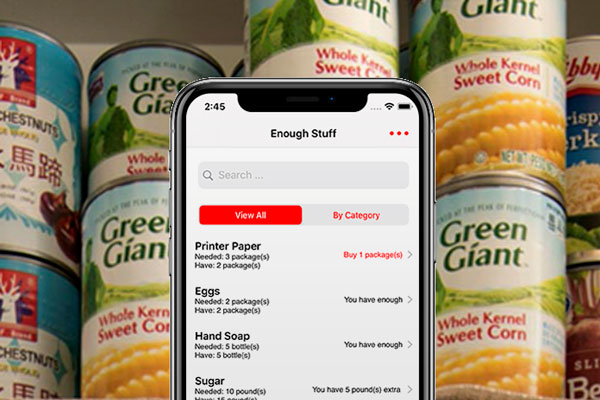
Enough Stuff App
The Enough Stuff inventory app for iOS helps you keep track of how much you have of items so you don't buy more of them than you need.

Green Thumbometer App
The all-in-one iOS app that's a gardening calendar, gardening journal, gardening to-do list and source of gardening information.

Salsa for the Holidays
Salsa is one of America's most loved foods. Here are some holiday fruit salsa recipes that are a nice change from tomato salsas.
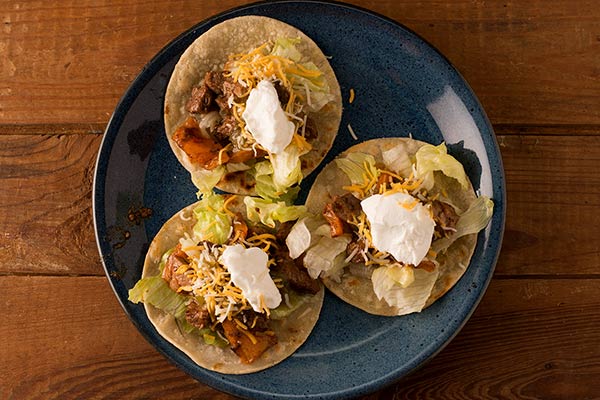
Favorite Sauces for Latin Dishes
Some of the best Latin foods can be made with easy commercial or homemade sauces that work in a variety of dishes.
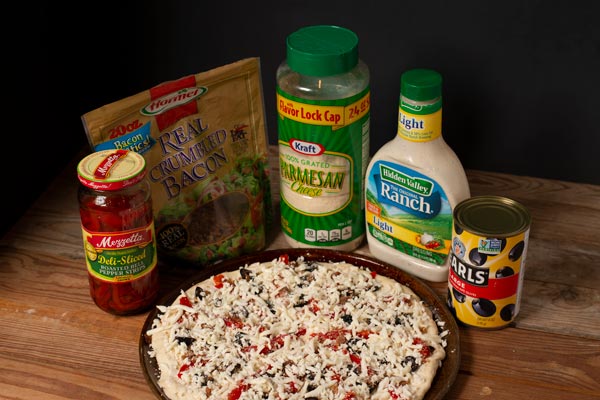
Store What You Eat Guidelines
The pandemic has been a major wake-up call about planning, home storage and preparation for crises. Here are some guidelines.
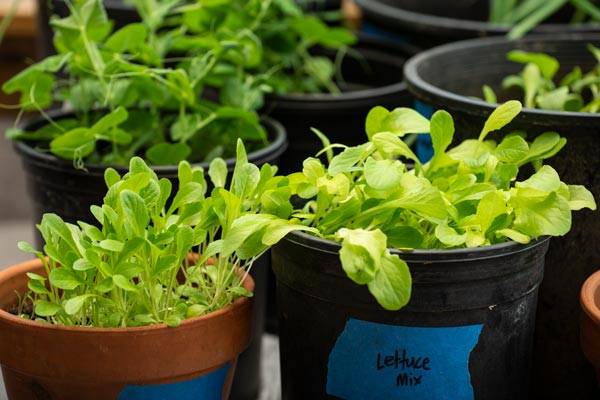
Return of the Victory Garden
A resurgence of gardening has accompanied sheltering at home during the pandemic, invoking victory gardens of the two world wars.
